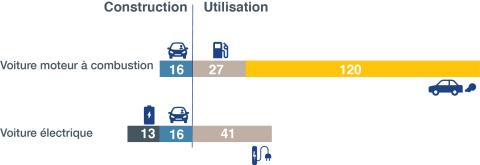Compare the CO2 emissions and costs of your vehicle
With carboncounter.lu, you can compare the CO2 emissions and costs of vehicles available on the Luxembourg market (all types of engines). Make up your own mind about the vehicle you are considering to buy, taking into account its engine, its economic cycle, its comparisons, as well as its life costs, maintenance, purchase, fuel, taxes, etc..
This free comparison tool developed by the MIT Trancik Lab in collaboration with Klima-Agence, works on the basis of neutral data, collected primarily from the SNCA (Société Nationale de Circulation Automobile), and according to a recognised scientific methodology.
Find oekotopten's recommendations on mobility as well as a comparative list of electric vehicles in Luxembourg.
Positive ecological balance and green electricity
As part of the national mobility strategy Modu 2.0, analyses were conducted for Luxembourg:

(CO₂ emissions for a full vehicle life cycle of 200,000 km)
Electric cars are more energy efficient and have a lower environmental impact than combustion engine cars:
- over their life cycle (200,000 km), they have a better ecological footprint than cars with combustion engines (70 g CO2/km versus 163 g CO2/km)*;
- this balance can be further improved* thanks to renewable sources of energy;
- they are silent and cause almost no local emissions (no NOx or CO2 emissions, less fine dust) and thus contribute to a better quality of air and life;
- Due to continuous optimisation of production, reuse and recycling of batteries, resource shortages can be avoided in the long term.
- Most electricity suppliers on the Luxembourg market offer products that are entirely based on renewable electricity**. Find more information on green electricity offers at www.oekotopten.lu or calculix.lu
* Modu 2.0, Transport & Environment, 2017
** ILR, press release, 11 January 2018
Besides the analyses undertaken under Modu 2.0, other scientific studies (grouped in the “Facts & Figures” section) show that today, over their entire life cycle, electric cars have an ecological balance that is significantly better than that of combustion engine cars, even when considering the load with the conventional electricity mix in Europe (not 100% green).
Implementing a CO2 tax
Like many other countries, Luxembourg will introduce a CO2 tax from 2021, amounting to €20 per ton of CO2 emitted. The rate will gradually increase in subsequent years to €25 per ton of CO2 emitted in 2022 and €30 in 2023.
This translates to an increase in prices at the pump of about 5 cents per litre of petrol and diesel. This measure is part of the implementation of the Integrated National Energy and Climate Plan (PNEC)) and contributes to meeting the CO2 emission reduction targets.
The government is stressing social fairness by providing social compensation measures. So, the tax credits for employees (CIS), pensioners (CIP) and the self-employed (CII) will increase from €600 to €696 as of 1 January 2021. In addition, the cost-of-living allowance will be increased by 10% as of the same date.
Consumption and exploitation of resources
The consumption of resources, especially lithium and cobalt, for batteries production is still an issue with plenty of room for improvement.
Batteries today already have a lifespan of about 15 years. When the battery capacity is no longer sufficient for use in electric cars, batteries can be given a “second life” as storage batteries for electricity generated by a photovoltaic system, for example.
Almost all batteries can be recycled at the end of their life cycle. In the European Union, 50% of the weight of batteries must be recycled. Two directives have also been proposed, designed to increase the recycling rate of batteries to 100% in Europe in the near future. The European Union is investing heavily in battery research and development to make production more efficient and sustainable.
The origin of cobalt is also an issue. Although there have already been great improvements as a result of increased demand and a more professional exploitation of resources, there is still potential for improvement. The European Union is analysing the potential of Europe's strategic material reserves to cover Europe's resource needs with local exploitation. There are also initiatives to create a label that guarantees that human rights are respected during resource exploitation.


